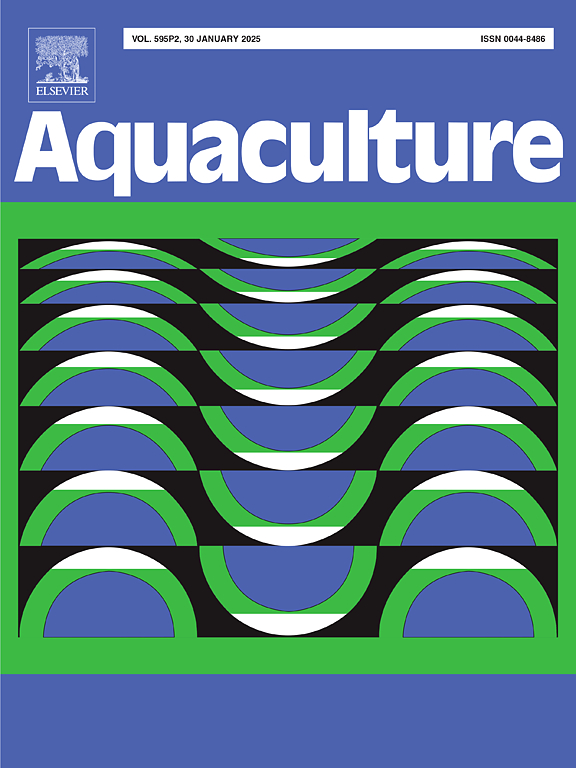基于元分析的工厂水交换模型与生物絮凝模型的经济和生态效益比较
IF 3.9
1区 农林科学
Q1 FISHERIES
引用次数: 0
摘要
目前,有关水产养殖模式的研究主要集中于评估单一的经济或生态效益,而对不同工厂化养殖模式的综合经济和生态效益的分析却鲜有报道。此外,关于多种养殖模式对环境的综合影响也缺乏全面的研究。因此,我们采用 Meta 分析法对不同工厂化养殖模式及其组合在多维条件下的经济和生态效益进行了量化和比较,包括室内超集约化对虾养殖模式(ISIC-S)、室内超集约化生物絮团对虾养殖模式(ISBIC-S)、室内超集约化循环对虾养殖模式(ISIRC-S)和室内超集约化鱼类养殖模式(ISIC-F)。结果表明,与单一工厂化养殖模式相比,多种工厂化养殖模式组合使用的经济效益和生态效益显著提高了 38%,其中单一效益的经济效益提高了 11%,生态效益提高了 88%。具体而言,与 ISIC-S 模式相比,ISBIC-S、ISIRC-S 和 ISIC-F 模式组合的经济和生态效益增加了 64.65%。与 ISBIC-S 相比,ISIRC-S 和 ISIC-F 的组合使经济和生态效益增加了 13.75%。在经济效益方面,由于养殖技术相似,四种工厂化养殖模式的成本结构相似,多种工厂化养殖模式组合的总成本仅增加了 6%。但由于养殖技术的成熟,ISIC-S 模式的净利润最高,达到 182 778.75 美元/公顷-1,优于单一模式,经济效益较好。在生态效益方面,与单一模式相比,多工厂模式显著减少了悬浮固体。对细菌多样性和碳汇能力的分析表明,ISBIC-S 和 ISIRC-S 模式的细菌多样性和丰度高于 ISIC-S,单位产量的碳排放量在 ISIC-F 模式中最高(1858.14 g kg-1CO2),其次是 ISBIC-S(1732.66 kg-1CO2)。总之,采用多种协同工厂化养殖模式是一种可行且可持续的方法,既能提高经济收益,又能显著改善生态环境。这些发现为开发促进水产养殖可持续发展的工厂化养殖模式提供了理论基础。本文章由计算机程序翻译,如有差异,请以英文原文为准。
Comparison of economic and ecological benefits between factory water exchange model and biofloc model based on meta analysis
Studies on aquaculture models currently focus on assessing single economic or ecological benefits, while the analysis of the combined economic and ecological benefits of different factory farming models has rarely been reported. Furthermore, there is a lack of comprehensive research on the combined effects of multiple farming models on the environment. Therefore, we used Meta-analysis to quantify and compare the economic and ecological benefits of different factory farming modes and their combinations under multidimensional conditions, including the Indoor super-intensive shrimp culture model (ISIC-S), Indoor super intensive biofloc shrimp culture (ISBIC-S), Indoor super-intensive recirculating shrimp culture (ISIRC-S), and the Indoor super-intensive fish culture model (ISIC-F). The results showed that the economic and ecological benefits of using a combination of multiple factory farming models were significantly increased by 38 % compared to a single factory farming model, with an 11 % increase in economic benefits and an 88 % increase in ecological benefits in a single benefit. Specifically, the economic and ecological benefits increased by 64.65 % for the combination of ISBIC-S, ISIRC-S and ISIC-F modes compared to ISIC-S. The combination of ISIRC-S and ISIC-F increased the economic and ecological benefits by 13.75 % compared to ISBIC-S. In terms of economic benefits, the cost structure of the four factory farming models was similar due to the similar farming technology, and the total cost of the combination of multiple factory farming models increased by only 6 %. However, due to the maturity of the farming technology, the ISIC-S model had the highest net profit of 182,778.75US$ ha−1 as compared to the single model, which was better in terms of economic benefits. Regarding ecological benefits, the multiple factory model showed significant reduction in suspended solids compared to the single model. The analysis of bacterial diversity and carbon sink capacity indicated that the bacterial diversity and abundance in ISBIC-S and ISIRC-S modes were higher than that of ISIC-S, and the carbon emission per unit of production was highest in ISIC-F (1858.14 g kg−1CO2), followed by ISBIC-S (1732.66 kg−1CO2). In conclusion, adopting multiple synergistic factory farming models is a feasible and sustainable approach to enhancing economic returns while significantly improving the ecological environment. These findings provide a theoretical foundation for developing factory farming models that promote the sustainable development of aquaculture.
求助全文
通过发布文献求助,成功后即可免费获取论文全文。
去求助
来源期刊

Aquaculture
农林科学-海洋与淡水生物学
CiteScore
8.60
自引率
17.80%
发文量
1246
审稿时长
56 days
期刊介绍:
Aquaculture is an international journal for the exploration, improvement and management of all freshwater and marine food resources. It publishes novel and innovative research of world-wide interest on farming of aquatic organisms, which includes finfish, mollusks, crustaceans and aquatic plants for human consumption. Research on ornamentals is not a focus of the Journal. Aquaculture only publishes papers with a clear relevance to improving aquaculture practices or a potential application.
 求助内容:
求助内容: 应助结果提醒方式:
应助结果提醒方式:


